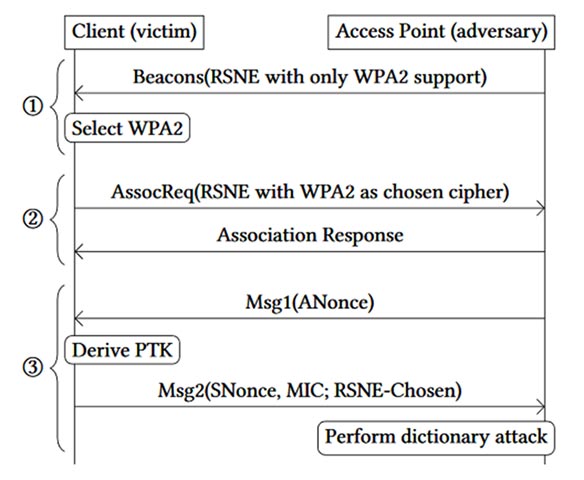Discover Dragonblood security vulnerability in WPA3
Security researchers have recently discovered several new security flaws in the WPA3-Personal protocol, allowing potential attackers to unlock Wi-Fi network passwords, and from there gain access to Encrypted network traffic, being exchanged back and forth between connected devices.
More specifically, according to a press release from the Wi-Fi Alliance, devices affected by these security flaws in the WPA3 Wi-Fi standard will "allow side-channel information collection on" The device runs the attack software, and will also not be able to perform certain encryption operations correctly, or lead to the use of inappropriate encryption elements'.

- Danger: Hackers can target medical devices, change medical examination and treatment results
Basically, WPA3 uses the Wi-Fi Device Provisioning Protocol (DPP) protocol instead of the shared password to log new devices into the network. This is a protocol that allows users to scan QR or NFC codes to log devices into the wireless network, replacing the traditional password usage method. In addition, unlike WPA2, all network traffic on WPA3 will be encrypted after connecting to a network system using WPA3 WiFi Security.
The WPA3-Personal protocol will replace the Pre-shared Key (PSK) in WPA2-Personal with simultaneous authentication (Authentication of Equals - SAE) to provide a more robust password-based authentication method.
Although WPA3-Personal is designed to replace WPA2 - a 14-year-old 'aging' protocol that is currently less secure, the Authentication of Equals (SAE) authentication method of the new protocol (also known as Dragonfly), although it is theoretically superior, it seems to be "stained" by some fundamental errors in the design process, causing user data to be exposed, and of course They will be at high risk of becoming the 'prey' of crooks. According to security researchers, the most optimal method used by an attacker to exploit this vulnerability is to use password partitioning attacks.
- Reveal personal data of more than 1.3 million people from a vulnerability in web application
Dragonblood attacks can be used to steal sensitive information
According to the study, two research experts Mathy Vanhoef (NYUAD) and Eyal Ronen (Tel Aviv & KU Leuven University) mentioned in their study: 'Basically, Dragonblood attacks are like those dictionary attack, and allows crooks to recover passwords by abusing buffer-based side-channel leaks (cache-based side-channel leaks). Side-channel attacks are often aimed at password encryption. '
In addition, the researchers also mentioned the need to build a website dedicated to analyzing attacks using the WPA3 Dragonfly handshake vulnerability, which could be abused to steal. Sensitive information is transmitted over Wi-Fi networks such as credit card numbers, passwords, private chat messages, emails, .

- Hackers antivirus application preinstalled on Xiaomi phones into malware
As explained in the summary of the research paper: "These attacks can be highly effective while the deployment cost is quite low, such as the 8-digit brute-force type password. Normal self costs less than $ 125 for Amazon EC2 use cases. "
Since the Dragonfly handshake used by Wi-Fi networks requires a user name and password to control access, it can also be used by the EAP-pwd protocol, causing all attacks. Dragonblood found to have an effect on WPA3-Personal is ready to be used against EAP-pwd.
"In addition, we have discovered some serious bugs that appear in most EAP-pwd deployment products. This allows an attacker to impersonate any user and thus access the network. Wi-Fi without knowing that user's password Although we believe that EAP-pwd currently used is not so popular, this could in theory still cause a serious security risk for many people, and demonstrate the risks when Dragonfly is deployed incorrectly, 'researchers said.

- Insider attacks are becoming more and more popular and difficult to detect
The KRACK WPA2 vulnerability has also been found
In general, the vulnerabilities found in WPA3-Personal have two types, namely side-channel leakage and downgrade attack, and both can be used by potential attackers to detect the password of the Wi-Fi network.
Security expert Mathy Vanhoef and his team have also discovered KRACK attacks (short for 'short for key reinstallation attack'), directly affecting the WPA2 protocol. At the time of discovery, KRACK affected "all protected Wi-Fi networks".

- The alarming increase in the number of attacks targeted at IoT devices
Device manufacturers started deploying security patches
'A more open process will help prevent (or clarify) the possibility of downgrade attacks against WPA3-Transition mode. However, although WPA3 still fixes certain errors, we still consider it a significant improvement over WPA2 ', the researchers concluded.
According to the report of the Wi-Fi Alliance, all of the above problems can be mitigated or prevented through software updates without having to implement any impact on the functionality of devices. There is no evidence that these vulnerabilities have been exploited on a mass scale, and manufacturers with affected devices have also begun to deploy patches to solve the problem.
You should read it
- Summary of popular network attacks today
- Compare 4 types of security WiFi WEP, WPA, WPA2 and WPA3
- What is WPA2 (WiFi Protected Access 2)?
- KRACK attack breaks down the WPA2 WiFi protocol
- How to hack WiFi passwords with holes on WPA / WPA2
- The unsafe 'feature' on UC Browser allows hackers to take control of Android phones remotely
- What is the newly announced WPA3 WiFi security protocol?
- Upgrade Wi-Fi security from WEP to WPA2
May be interested
- Critical Vulnerability Discovered in 3 WordPress Plugins, Affects 84,000 Websites
 security researchers have just disclosed a new vulnerability affecting three different wordpress plugins, posing a security risk to 84,000 websites. by exploiting this vulnerability, hackers can take control of the affected websites.
security researchers have just disclosed a new vulnerability affecting three different wordpress plugins, posing a security risk to 84,000 websites. by exploiting this vulnerability, hackers can take control of the affected websites. - Detected critical zero-day vulnerability on Adobe Reader
 adobe has just released the may security update to patch security holes in 12 of their products. among them is a serious zero-day vulnerability in adobe reader that is being actively exploited by hackers.
adobe has just released the may security update to patch security holes in 12 of their products. among them is a serious zero-day vulnerability in adobe reader that is being actively exploited by hackers. - Discovered a new zero-day vulnerability on macOS that allows attackers to run commands remotely
 an international team of security researchers has publicly disclosed a new vulnerability that exists in apple's macos finder.
an international team of security researchers has publicly disclosed a new vulnerability that exists in apple's macos finder. - Detecting zero-day vulnerability in the Dropbox 10 Windows app, users pay attention!
 a group of free security researchers recently announced the zero-day vulnerability in the dropbox version of the windows app.
a group of free security researchers recently announced the zero-day vulnerability in the dropbox version of the windows app. - Detecting a new Linux vulnerability allows hackers to gain control of the VPN connection
 international security researchers have found an entirely new linux vulnerability that allows potential attackers to hijack vpn connections on the device * nix and 'inject' the arbitrary data payload into it. tcp4 and ipv6 streams.
international security researchers have found an entirely new linux vulnerability that allows potential attackers to hijack vpn connections on the device * nix and 'inject' the arbitrary data payload into it. tcp4 and ipv6 streams. - Detecting an 8-year-old security flaw, affecting 150 HP printer models
 researchers have discovered several security vulnerabilities affecting at least 150 models of hp multifunction printers (print, scan, fax).
researchers have discovered several security vulnerabilities affecting at least 150 models of hp multifunction printers (print, scan, fax). - Network security guide before vulnerability 196
 first we need to understand the attacks using this vulnerability must be done within the network. the culprit must have network certificates and need to have a successful connection to your network.
first we need to understand the attacks using this vulnerability must be done within the network. the culprit must have network certificates and need to have a successful connection to your network. - New zero-day vulnerability warning in Windows Search, Windows protocol nightmare getting worse
 a new windows search vulnerability can be exploited to automatically open a search window containing remotely hosted malicious executable files just by launching a word document.
a new windows search vulnerability can be exploited to automatically open a search window containing remotely hosted malicious executable files just by launching a word document. - Microsoft urgently patched zero-day vulnerability after 2 years of refusing to acknowledge it
 microsoft has just released security updates to fix a high-severity zero-day vulnerability in windows.
microsoft has just released security updates to fix a high-severity zero-day vulnerability in windows. - Detected a serious BIOS vulnerability, affecting many Intel processors
 located in the bios, two newly discovered vulnerabilities allow hackers to perform malicious attacks on the victim's system.
located in the bios, two newly discovered vulnerabilities allow hackers to perform malicious attacks on the victim's system.










 The hyperlink test command is being used by hackers to perform DDoS
The hyperlink test command is being used by hackers to perform DDoS 25% of 'over-the-counter' phishing emails are the default security of Office 365
25% of 'over-the-counter' phishing emails are the default security of Office 365 Authentication tool on many enterprise VPN applications that are bypassed by hackers
Authentication tool on many enterprise VPN applications that are bypassed by hackers Adblock Plus filter can be exploited to run malicious code
Adblock Plus filter can be exploited to run malicious code There were 12,449 serious data breaches recorded in 2018, an increase of 424% compared to 2017
There were 12,449 serious data breaches recorded in 2018, an increase of 424% compared to 2017 KB4482887 update patched the Specter vulnerability, but it caused problems for some Windows 10 games
KB4482887 update patched the Specter vulnerability, but it caused problems for some Windows 10 games